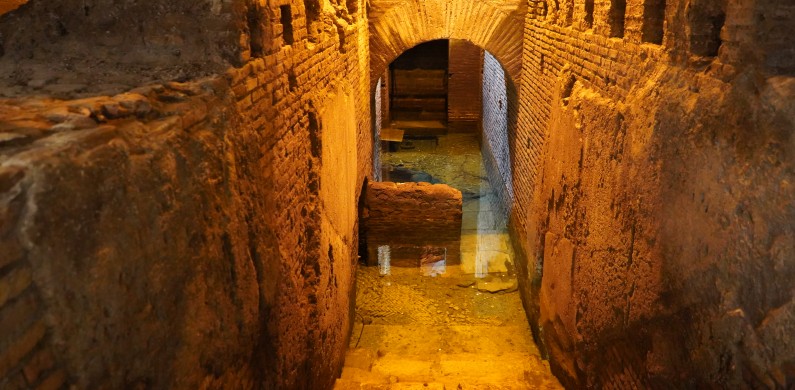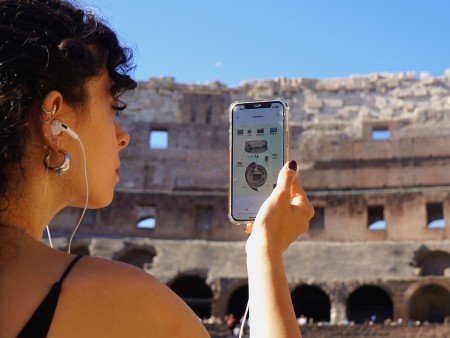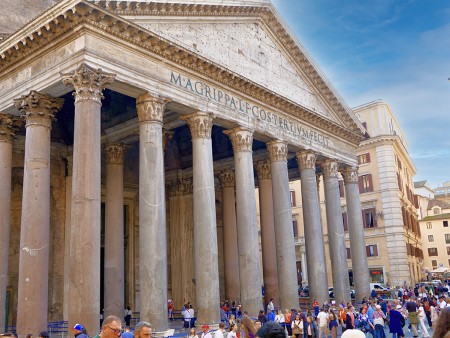Private Trevi Fountain Underground Tour & Overground Adventure
Explore the undergrounds beneath the Trevi Fountain, architecture and history of the Pantheon and Piazza Navona on our private tour
Explore the story of water with a private tour of the stunning Trevi Fountain, as your guide shows you its Baroque charm, how it changed over the centuries, and the clever engineering of the ancient Aqua Virgo aqueduct, still flowing today. Flip a coin, listen to its legends and get ready to literally dive into Rome’s underground, and into its thousands of years of history.
Descend into the Vicus Caprarius, the Trevi Fountain underground labyrinth of 1st-century Roman houses. Marvel at mosaics, frescoes, and sculptures as your guide brings this secret world to life, revealing how ancient Romans lived and engineered their water systems.
Then, emerge to the sunlight before the magnificent Trevi Fountain, the Baroque celebration of that same ancient aqueduct. Marvel at its theatrical sculptures and cascading waters as your guide unveils its artistic evolution through the centuries, the legends surrounding it, and the enduring ritual of tossing a coin to ensure your return to Rome.
Continue to Piazza Colonna, home to the Column of Marcus Aurelius. Your guide will decode the intricate carvings, recounting the emperor’s victories and showcasing the power of imperial Rome.
Visit the awe-inspiring Pantheon, a masterpiece of ancient architecture. Learn how its unreinforced concrete dome has stood the test of time and discover the stories behind its transformation from pagan temple to Christian church.
Just a short stroll away, discover the breathtaking Church of St. Ignatius of Loyola, a Baroque masterpiece dedicated to the founder of the Jesuit order. Gaze upward at Andrea Pozzo’s spectacular illusionistic ceiling, where painted architecture seems to dissolve into an infinite sky. Your guide will reveal the ingenious tricks of perspective that make this fresco one of the most astonishing optical illusions in Rome.
Be astonished by Piazza Navona, built on Domitian’s ancient stadium. Admire Bernini’s Fountain of the Four Rivers and soak in the lively atmosphere as your guide shares stories of Baroque rivalry, hidden details, and local tips.
After exploring the depths of the Trevi Fountain, discover more hidden gems with our Castel Sant'Angelo and Villa Farnesina Tour.
If you’re fascinated by Rome’s underground, continue your journey with our Underground Rome Tour with Catacombs.
Duration
3 hour
Private Tour
TOUR INCLUDES
Vicus Caprarius tickets (Trevi Fountain Underground)
Licensed guide with degree in archaeology, history or art history
Dynamic Passionate Guides, with perfect English and narrative skills
Itinerary carefully designed by our expert team
TOUR does't include
Private transfer
Food and Drinks
Main sites Explored in the Tour
Vicus Caprarius (Trevi Fountain Underground)
Trevi Fountain
Pantheon
Piazza Colonna
Church of St. Ignatius of Loyola
Piazza Navona
Wonders discovered
Opening hours and Entry Tickets for this tour
2025 - Trevi Fountain Underground Access Hours
- Tuesday - Sunday 11:00 AM - 5:00 PM
Closure Days
On the first Sunday of the month admission is free, so tickets can only be purchased at the ticket office in Piazza del Colosseo, located near the Temple of Venus and Rome, and at the ticket office in Largo della Salara Vecchia.
- 1 January
- 25 April
- 4 May
- 1 June
- 2 June
- 25 December
The Trevi Fountain: Baroque Splendor and Timeless Legends
Your Rome Tour begins at the iconic Trevi Fountain, Rome’s theatrical ode to water and power. Though today it’s often surrounded by tourists and coin-tossing visitors, the Trevi’s story is one of engineering brilliance, imperial ambition, and baroque imagination. Your guide will explain to you every layer of its legacy, beginning with its ancient heartbeat: the Aqua Virgo roman aqueduct. Commissioned by Marcus Agrippa in 19 BC, this aqueduct was not merely a utilitarian project, it was a real political gesture of generosity, bringing clean water from 20 kilometers away to serve the Roman baths and fountains, cementing the bond between emperor and citizen.
Fast-forward to the 18th century, and Rome was yearning for a grand fountain worthy of its ancient water source. Nicola Salvi, chosen to design it, infused every sculptural detail with symbolic meaning. Framed in a triumphal arch, Oceanus, the mythic titan of the world’s waters, surges forward in a shell chariot led by sea horses, one calm, one wild, mirroring water’s dual nature: life-giving and chaotic. The architectural setting is no passive backdrop, it mimics a triumphal arch, placing Rome’s dominion over nature in full theatrical display. As you stand before this roaring cascade, you’ll hear not just the flow of water but the echo of centuries of Roman pride, power, and myth.
And what about the coin toss? Your local guide will reveal how this ritual emerged from a blend of folklore and film. Indeed, Ancient Romans, thousands of years ago, were already tossing coins into rivers, lakes, and fountains to win the favor of water deities and to bring themselves good fortune, especially before embarking on a journey. This belief in the fountain’s "magical" aura continued well into papal Rome. One charming custom held that when a young man was about to leave the Eternal City, his beloved would bring him to the Trevi Fountain. There, she would offer him a drink from a cup, filled with the fountain’s water. Then, the cup would be shattered. The gesture symbolized a bond that distance could never break, an unbreakable love sealed by the sacred waters of Rome. That sip has today been replaced by a coin toss, the result today? Over 3,000 euros collected daily, proof that even in a secular age, Rome still inspires wishes.
Descend Beneath the Streets: The Hidden World of Vicus Caprarius
Just a stone’s throw from the fountain’s glamour lies a passage into ancient Rome’s intimate side. Nine meters beneath the Trevi Fountain, the Vicus Caprarius, also known as the "City of Water”, is an archaeological site that unveils a rarely seen layer of Roman life. What you’ll discover here is not monumental grandeur but something far more evocative: the everyday textures of a neighborhood that pulsed with life almost two thousand years ago.
Descend through your Trevi Fountain Underground Tour admiring the remains of a vast Roman apartment building, which once housed both upper-class citizens and commoners. Its walls are still standing, bearing traces of structural details that suggest multiple levels and a bustling, densely populated environment. These residences were positioned in a thriving district supplied by one of Rome’s most important aqueducts, the Aqua Virgo aqueduct. Commissioned by Agrippa in 19 BC and still functioning today, the aqueduct not only powered the Trevi Fountain above but also supplied fresh water to the homes and public baths in this quarter. You can even see the ancient distribution tank that regulated water flow through lead pipes, the so called “castellum aquae” a striking reminder of Rome’s sophisticated hydraulic infrastructure and engineering skills.
Scattered throughout the site are dozens of amphoras, large terracotta storage vessels once used to transport wine, oil, and grains. Some were recycled as plumbing elements, while others were buried upright to act as makeshift drainage or storage systems. These aren’t museum pieces under glass; they will be right in front of you, offering a rare connection to daily Roman routines. Many were found intact, and their stamped seals provide clues to trade routes and economic life across the empire.
Stand in Awe at the Pantheon: Rome’s Architectural Miracle
Emerging from the underground, your private guide will lead you to the Pantheon, a site so extraordinary that even modern architects marvel at its perfection. More than just a structure, the Pantheon is a testament to the ingenuity and ambition of ancient Rome. Built in 126 AD under Emperor Hadrian, it stands as the best-preserved monument of its time. Your guide will unveil the secrets behind its revolutionary design, from the massive unreinforced concrete dome—still the largest of its kind in the world—to the oculus, a celestial opening that illuminates the space with natural light.
But the Pantheon is more than a marvel of engineering. It’s a bridge between the sacred and the practical. Originally a temple to all Roman gods, it later became a Christian church and today serves as the burial place of kings and artists, including Raphael. Your guide will share fascinating insights about its construction, including the materials sourced from across the empire, and how it represents the Roman ideal of harmonizing beauty, utility, and spirituality. A visit here is not just a step back in time—it’s an encounter with the genius of a civilization that shaped the world.
Discover Piazza Colonna: Imperial Power Carved in Stone
Piazza Colonna is a square that embodies the enduring power of Rome’s emperors. At its center stands the Column of Marcus Aurelius, an intricately carved triumphal column that recounts the emperor’s military campaigns in stunning detail. With your guide’s expert storytelling, you’ll see the carvings come alive: soldiers crossing rivers, battles against barbarian tribes, and the intervention of the gods.
But Piazza Colonna isn’t just about the column. Your guide will delve into the surrounding buildings, including the Palazzo Chigi, now the seat of the Italian Prime Minister. Learn how this square evolved from an imperial showcase to a hub of modern political life, all while retaining its historic charm. A visit here provides a unique opportunity to see how Rome’s past continues to shape its present.
Piazza Navona: Baroque Splendor with Ancient Roots
Your private Rome tour concludes at Piazza Navona, a square that captures the very essence of Rome: vibrant, layered, and endlessly fascinating. Once the site of Domitian’s Stadium in the 1st century AD, the square still retains the elliptical shape of the ancient athletic arena. Your guide will bring the history of the stadium to life, recounting tales of gladiatorial games and athletic competitions that once thrilled the Roman masses.
Today, Piazza Navona is a showcase of Baroque art and architecture. The highlight is Bernini’s Fountain of the Four Rivers, a stunning masterpiece that symbolizes the Danube, Nile, Ganges, and Rio de la Plata. Your guide will reveal the rivalry between Bernini and Borromini, the two master architects of the era, whose tension played out in the design of the square’s fountains and churches. As you stroll through the lively piazza, filled with street performers, artists, and cafés, your guide will share local insights, from the best places to sip espresso to hidden details most visitors overlook.
Request your Private Tour
From € 250
Fill Out The Form Below
By submitting this form I agree to the processing of my personal data as indicated in the privacy policy
Last Reviews
[5.0]
I uncovered so much history on our Trevi Fountain underground tour, thanks to our incredibly informative guide. Highly recommended!
Our Trevi Fountain underground tour with our guide Luca was the highlight of my trip to Rome. Don’t miss it!
You may also like ...











